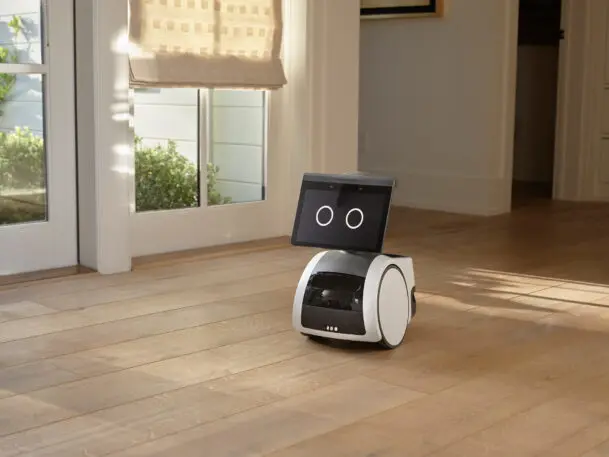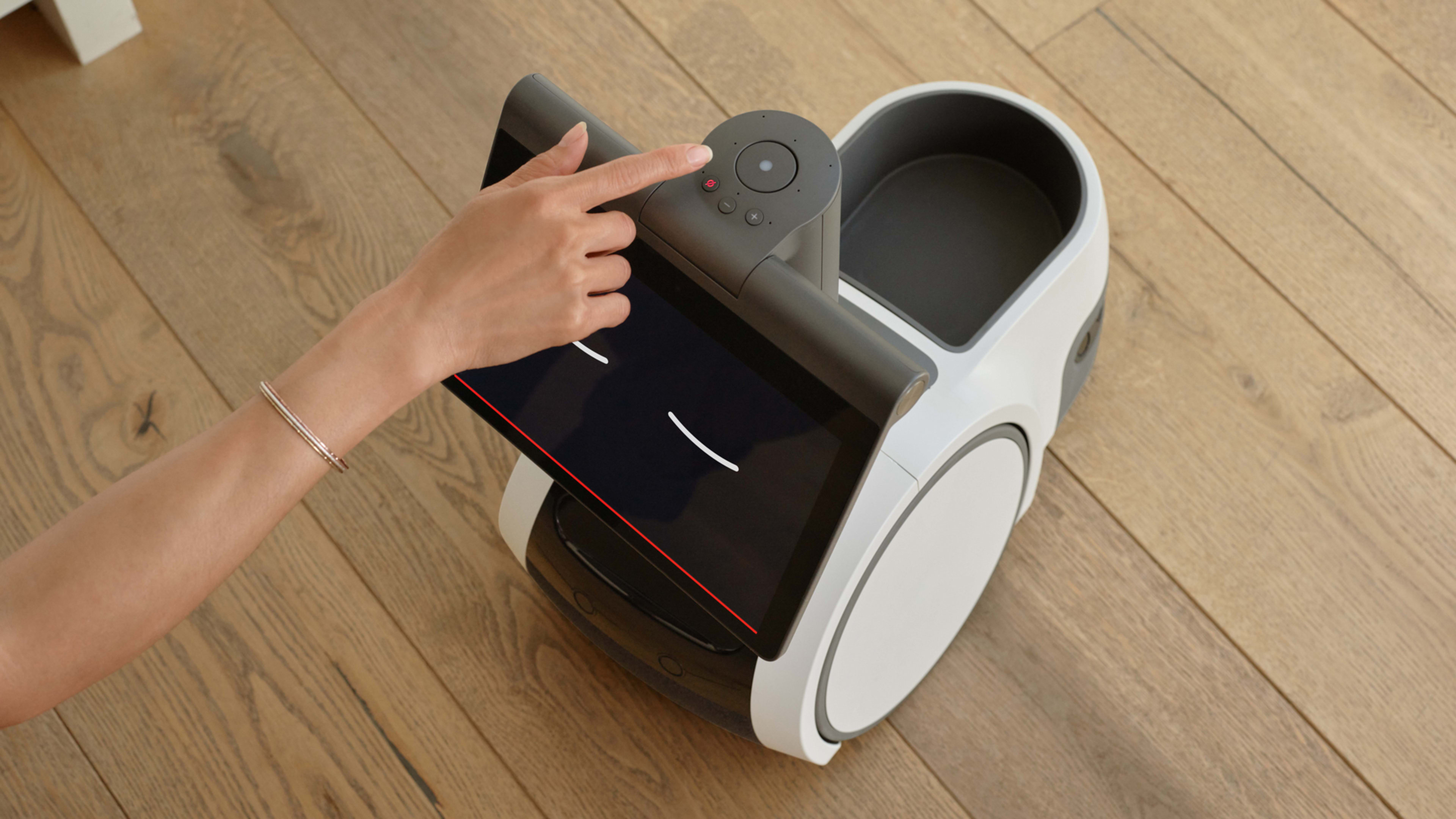Amazon Astro is the rare tech product that makes a point of getting in your way.
For the past few weeks, I’ve been living with Amazon’s $1,450 autonomous robot, which can follow you around while delivering reminders, playing music, or carrying small objects on its back. Astro can also check on things around the house and send live video to your phone, plus it can patrol for intruders when you’re not home. (The robot is currently selling at a discounted price of $1,000 on an invite-only basis.)
But while Astro is a technological marvel, none of its major-use cases resonated with me, and its various attempts at making its presence known—bleeping at you when you walk by, for instance, or camping out in random spots around the house—quickly became grating. My wife wants it gone as soon as possible.
None of which means that home robots are a fundamentally bad idea. But if Amazon wants Astro to become the robot butler of the future, it’ll have to become less of a burden and more of an invisible hand.
Getting situated
The first thing I did after receiving the Astro review unit was put off setting it up.
Getting Astro situated is inherently an ordeal, requiring face and voice scans along with a guided tour of the house for room-mapping purposes. The process can take about 50 minutes, and Astro encourages you to clear the floor of obstructions—a never-ending challenge with young kids at home—before getting started.
Once I started the Astro’s orientation, I soon hit a snag: Our living room has a step-down, which Astro can’t navigate, and on two occasions the robot rolled too close, froze up with fear, and canceled the entire mapping operation. The only way I could complete the setup was by erecting a temporary barrier of couch cushions along the ledge, tricking Astro into seeing it as a wall. It hasn’t ventured near the step-down since.

Once it’s set up, Astro responds to its name by looking in your direction with its 10-inch touchscreen, wheeling around to face you if necessary. You can ask it to go to a specific room, find a specific person, or just follow you around. With the Astro app, you can also drive the robot manually while looking through its camera and set up “Viewpoints” that you might want to quickly check on in the future, such as the view out your front window.
That any of this works at all is impressive, but it’s seldom as frictionless as talking to the nearest Echo or HomePod speaker. Astro isn’t great at hearing you if you’re in another room, and while you can always use another Alexa device to summon the robot remotely, there aren’t a lot of uses that justify waiting for it to show up.
So, what’s it for?
My bigger issues with Astro didn’t have to do with the setup, but with figuring out what to do with the thing.
Sure, Astro can follow you around the house while playing music, or track you down for any reminders that you’ve set, but for those uses the robot is more tiresome to deal with than a dedicated smart speaker. You have to make sure it’s nearby first, and that it has ample battery life to shadow you around the house. Astro also has a tendency to get uncomfortably close when it’s in follow mode, requiring more voice commands to make it back off.
And maybe I’m just too jaded of a tech journalist, but Astro’s parlor tricks got old quickly. My house isn’t so large that I need a robot to shuttle a can of beer around; and Astro’s periscoping camera, while convenient for selfies, can’t match the quality of a decent smartphone. Asking your pet robot to dance is something you only need to see once, and its rendition of Happy Birthday—all melodic bloops and bleeps—was equal parts amusing and unnerving. At night, the eerie glow of its touchscreen eyes and night vision light were even freakier.
The security robot
Ken Washington, Amazon’s vice president of software engineering for consumer robotics, says that, above all else, Astro is most useful as a security mechanism. It can monitor places where you don’t want a permanent camera, such as a bedroom, along with places you didn’t think to install a camera in the first place, such as your oven.
Still, those use cases demand some creativity on the user’s part. I didn’t even consider the oven scenario until Washington pointed it out to me in an interview, and because Astro can only remember one floor plan at a time, sending it to your bedroom may not even be feasible. You can’t move Astro to another floor without having to run the entire room-mapping routine all over again. (I also submit that we’ve gotten along fine so far without sending cameras into every corner of our homes.)
Setting up Astro for security isn’t exactly effortless, either. Astro isn’t smart enough to automatically recognize when no one’s home, which means you must remember to put it in Away mode when you leave (though you can do this remotely through the Astro app, at least). And if you don’t remember to keep all your doors open, Astro’s patrol capabilities will be limited. It can’t open doors and won’t even attempt to nudge one that’s ajar.
As with everything else Astro does, all of this just requires a lot of thinking and planning and foresight, which runs counter to the idea that smart homes are supposed to eliminate hassle. While I’m sure some people will delight in tinkering with Astro and pushing its boundaries, for me it became yet another gadget to accommodate with little clear payoff in return, a highly sophisticated example of tech for tech’s sake.
Just getting started
It’s still early days for Astro, which Amazon refers to as a “Day 1 Editions” product. If you get an invite to buy one, you’re essentially a beta tester that’s helping Amazon figure out what to do with it. Some Day 1 releases, such as the Echo Loop smart ring from a few years ago, never graduate beyond this stage.
Amazon’s Ken Washington won’t say whether Astro will eventually shed its Day 1 Editions status, but he says the company is committed to Astro and to robots in general. He seems receptive to the notion that Astro can require too much hand-holding or even be off-putting.
To that end, the company is still improving Astro’s navigation algorithms and wants to add more specific ways of interacting with pets and children. Plans to make Astro work in small business settings are also on the table, as are ways for third-party developers to give the robot new skills. Even Astro’s status as a voiceless robot—technically, it hands off queries to Alexa if they require a spoken answer—is up in the air.
“We have really ambitious plans for Astro,” Washington says. “It’s our first robot, it’s not going to be our last robot, and it’s going to get better over time.”
In the meantime, I’m looking forward to sending it back.
Recognize your brand’s excellence by applying to this year’s Brands That Matter Awards before the early-rate deadline, May 3.
